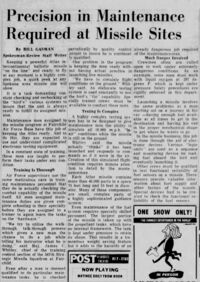1964-04-07-sr-p16-missile-maintenance
April 07, 1964 Spokesman-Review Page 16:
Precision in Maintenance
By BILL GASMAN
Spokesman-Review Staff Writer
Keeping a powerful Atlas intercontinental ballistic missile "on the line" and ready to fly at any moment is a highly complex job, a quick peek at any Spokane area missile site will show.
It is a task demanding constant checking and rechecking of the “bird's” various systems to insure that the unit is always ready to fulfill its assigned mission.
Maintenance men assigned to the missile program at Fairchild Air Force Base have this job of keeping the Atlas ready. And to do this, they are expected to use and understand complicated electronic testing equipment.
In a constant state of training, these men are taught to perform their tasks under any condition.
Training Is Thorough
Air Force supervisors use the same meticulous care in training maintenance personnel that they do in actually checking the combat capability of the missile itself. All men assigned maintenance duties are given complete schooling in their specialty before they are assigned to a trainer to again learn the tasks on the "hardware."
“We try to utilize the walk through, talk-through process which gives a new man the chance to do a job while telling his instructor what he is doing,” said Maj. James C. Whitley, chief of the training control section of the 567th Strategic Missile Squadron at Fairchild.
Even after a man is deemed qualified to do particular maintenance tasks, he is checked periodically by quality control people to insure he is continually qualified.
One problem in the program is keeping the men ready without having actual practice in launching live missiles
"We have to simulate flight conditions on the ground," Whitley said. An elaborate testing
System is used constantly to test the bird's "Go" capability. Specially trained crews must be available to conduct these tests.
Testing Is Complex
A highly complex testing system has to be designed to give maintenance men the ability to simulate all 16,000 m.p.h. "in air" conditions while the missile is still on the ground.
Whitley said the missile actually "thinks" it has been launched and responds to commands as if it were in the air. Creation of this simulated flight condition requires minute attention to detail by the maintenance man,.
Each Atlas missile contains more than 40,000 parts in a space 75 feet long and 10 feet in diameter,Many of these components are small, complex parts of highly sophisticated guidance system.
Even maintenance of the fuel system requires specially skilled personnel. The largest portion of the missile is taken up with the propellant tanks, which have no internal framework. The tank is kept under pressure to retain its shape. This results in a tremendous weight saving feature but it adds to the hazards of an already dangerous job required of the maintenance man.
Much Danger Involved...
Crewmen often are called upon to work under extremely dangerous conditions. As an example, some men must work with liquid oxygen at -297 degrees F. which is kept under pressure. Safety procedures are rigidly enforced in this department.
Launching a missile involves the same problems as a man starting out on a journey in his car—having enough fuel available at all times to get to the destination and having his car in the proper mechanical shape to get where he wants to go.
In the missile business, this job is done through the aid of electronic devices, Various "logic units" are used as a sequence and monitoring device for loading fuel aboard the bird and eventually launching it
Other crews must be qualified to test functional reliability of fuel sensors on a missile, These sensors provide valuable information about fuel supply and other factors of the missile. Special devices had to be created to check the functional reliability of the fuel sensors.
